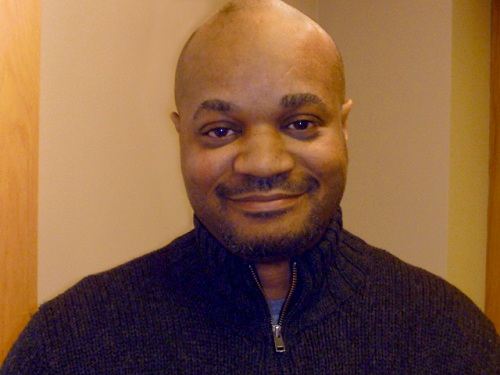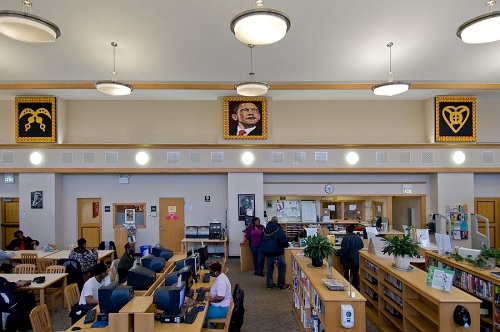“FIVE” is a special feature at BlackArtistNews where five questions are posed to an individual artist, curator, gallerist, collector or art lover. Why five questions? Well, there are five fingers on each hand and artists create with their hands hence one, two, three, four, FIVE.
 |
| Ian Weaver. BlackArtistNews photo. All rights reserved. |
Ian Weaver is an artist gratified by his interpersonal relationships. It's safe to assume that aspects of the bonds created with family, friends, fellow artists and the communities where he gives art lessons informed (and inspired) the fictional world of his solo exhibit Ian Weaver: An Incomplete History (2004-2011) on view June 18th through September 4th at the South Bend Museum of Art. With intelligence and imagination the Chicago-based artist deftly crafted and assembled materials that -- according to the museum's overview -- "speak to the larger concept of how we, as individuals, communities and societies construct our own narratives, identities, and memories." Weaver recounted his own narratives and memories for BlackArtistNews during a reception celebrating the installation of his triptych painting "Barack Obama and the Principles of Courage and Hope" at the Chicago Public Library's West Englewood Branch where he responded to "FIVE":
What’s your connection to the Englewood community?
I was born in the area. I was born at the University of Illinois Hospital but then I grew up over at 64th and Yale so technically I’m from the area. Then I moved much further south, but I [still] have a strong connection: I’ve done workshops and things at schools in the community.
Are you aware of the fact that Richard Hunt, Charles White and Archibald Motley each lived in Englewood?
I knew about Motley. I didn’t know about Richard Hunt. Actually, I have a connection with Richard Hunt through another person – a printmaker that [Hunt is working] with right now.
Since we’re on the subject of community, what’s your support system?
Personally? Well, right now I’m teaching. I teach at the School of the Art Institute [of Chicago] in two different departments. I’m in the painting and drawing department and then their first year program so that’s one thing, but you know adjuncts don’t make very much money.
I’m sorry, I didn’t mean financially, I meant support in terms of family or people in your corner that support and nurture your artistic expression.
That’s okay. I think all of them are important. You definitely need the financial in order to make the work but even if you have a lot of money and you don’t have the support it’s very difficult. My family has always been a big supporter of my work – my mom in particular. I grew up with a single mom – five kids in the family total – and she [worked] two sometimes three jobs to support us. But the funny thing is when I tell my students at the Art Institute – which is a completely different demographic quite honestly – they’re shocked out of their seats. But when I go to Kennedy-King [College, one of the City Colleges of Chicago located in Englewood] and I lecture they understand that unfortunately, it’s the norm. The expectations are already there to succeed regardless of what situation you’re born into. That’s something really important for the students to realize. But in terms of my support outside [of] financial [it’s] definitely my family. Also the family of artists that I have; A couple of those people will be coming out tonight – my friend Sadie Woods who’s a really well-known local dj with her partner Madrid. They run White Label; they do all sorts of programs and events [related to] art [and] fashion, so they’ve got their hands into many things. And I know Kerry James Marshall. He’s been a big supporter in the sense of always giving me advice [with] basic things like writing letters of recommendations [and] stuff like that.
How did you meet Kerry James Marshall?
Um, he was a part of an exhibit at the Block Museum [in Evanston, IL] back in the mid-nineties, so I’ve known him for a while. And I went out there…actually to backtrack: A former instructor of mine at Columbia College – which is where I did my BA – came by for a studio visit. This was like in the early nineties and she said you know “if you’re starting to think about these ideas of identity you may want to look at this artist Kerry James Marshall who’s getting some press right now.” [This was] before [he received] the "genius" grant and everything else. So I took that opportunity and went there ‘cause he was in this group show there at the Block for American printmakers or I think it was Chicago-based printmakers, historically like maybe 1945 to present. So I [walked] up to him and talked to him and he was very open. He’s always been open to students; you know he taught for years at the University of Illinois at Chicago. He’s especially open – to be frank – with students of color.
Okay.
And so I’ve maintained connections with him and whenever I’ve had a show or [received a] grant he’s always emailed me and said congratulations on that. He’s really a good guy. He’s a senior figure – I mean he’s not senior, he’s not old – but for me he’s like a senior figure that I look up to. So I think all of those – the art community and my family community would be that sort of support. And then of course like I said the financial support is a totally different thing as well.
 |
| Ian Weaver. Barack Obama and the Principles of Courage and Hope (2009) Oil, enamel and acrylic on wood panels Center panel: 48"x 60"; Left and right panels: 60"x 48" (Courtesy of the artist.) |
Do you set aside time to create art or do you work according to mood?
Nooooo, I have to be really disciplined. (Laughs) ‘Cause if I wasn’t it wouldn’t get done. To be honest, at heart I don’t have that in me. I need to really have things completely organized. Partly because I’m doing a lot of different things; [along] with the teaching and the workshops, I travel. I just recently came back from New York for a quick weekend to see some things there.
Did you see the Glenn Ligon show?
I didn’t get to that. I saw Willie Cole’s work at the Met though.
Cool.
And I’m on Facebook and I’m the one who posted about the Ligon show and somebody sent me an email when I said I was going to New York [they wrote] “don’t forget the show.” But I was there for three days. I always go to the Met and MoMA for sure. But I was kicking myself….I’ve never been to the Whitney. There are so many museums; New York is so big. I went to the Brooklyn Museum for the first time.
I like the Brooklyn Museum.
I like it. It’s a nice size. It’s a beautiful building.
I assume you saw the Lorna Simpson: Gathered exhibit that’s there now.
Yes! Yes! It was beautiful. That’s in their [Elizabeth A. Sackler Center] and I also saw [Judy Chicago’s] Dinner Party for the first time and that’s like a seminal piece for feminist art. But yeah, the Lorna Simpson stuff was really beautiful. In particular the found photos that she collected. The images are small and very haunting, really beautiful. The Brooklyn Museum’s got it going on; you walk in the lobby the first thing you see is a Kehinde Wiley image. I think it’s nice.
Does art matter?
Oh, of course! (Laughs) It matters in so many different ways. I work in the Chicago Public School system doing workshops and you know that’s generally the first program that’s cut. For me growing up, I made connections through art to geography [and] history. I didn’t have any of that information just through my geography classes or my history classes – and I went to pretty good schools. [But] you [can] learn about all those different things through the filter of art. I think for students it’s a lot easier for them to learn through that filter. So in that sort of basic literal sense it matters. [But] that justification shouldn’t be the only reason that it matters. It matters because if you’re living in a culturally reflective society you need to have an appreciation of art.
At this point, an unidentified gentleman (who stood by quietly during the interview) raised his hand and said: “It makes us human.”
Yeah! It definitely does and I think that that’s so vital.
 |
| Installation view of Ian Weaver's Barack Obama and the Principles of Courage and Hope (2009), West Englewood Branch Library, Chicago, IL. Photo courtesy of the artist. |

No comments:
Post a Comment